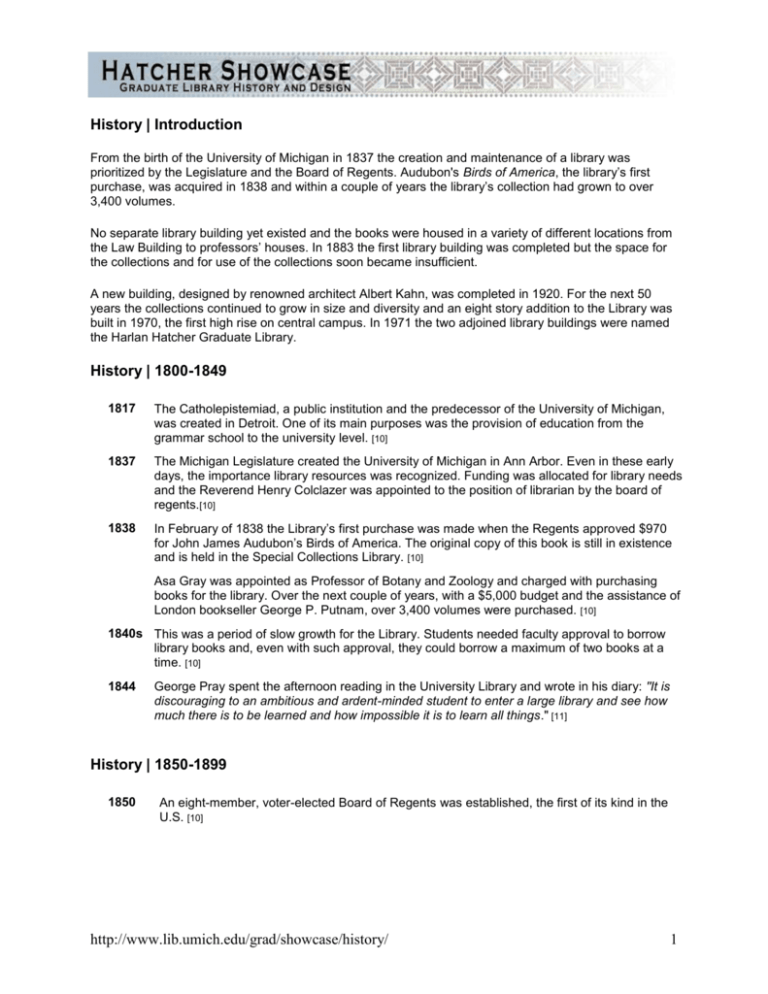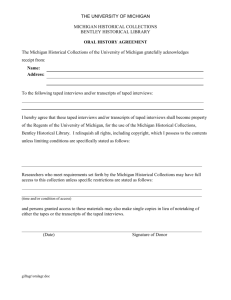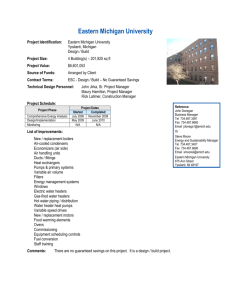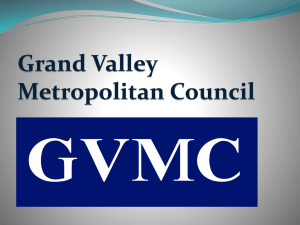History | Introduction - University of Michigan Library
advertisement

History | Introduction From the birth of the University of Michigan in 1837 the creation and maintenance of a library was prioritized by the Legislature and the Board of Regents. Audubon's Birds of America, the library’s first purchase, was acquired in 1838 and within a couple of years the library’s collection had grown to over 3,400 volumes. No separate library building yet existed and the books were housed in a variety of different locations from the Law Building to professors’ houses. In 1883 the first library building was completed but the space for the collections and for use of the collections soon became insufficient. A new building, designed by renowned architect Albert Kahn, was completed in 1920. For the next 50 years the collections continued to grow in size and diversity and an eight story addition to the Library was built in 1970, the first high rise on central campus. In 1971 the two adjoined library buildings were named the Harlan Hatcher Graduate Library. History | 1800-1849 1817 The Catholepistemiad, a public institution and the predecessor of the University of Michigan, was created in Detroit. One of its main purposes was the provision of education from the grammar school to the university level. [10] 1837 The Michigan Legislature created the University of Michigan in Ann Arbor. Even in these early days, the importance library resources was recognized. Funding was allocated for library needs and the Reverend Henry Colclazer was appointed to the position of librarian by the board of regents.[10] 1838 In February of 1838 the Library’s first purchase was made when the Regents approved $970 for John James Audubon’s Birds of America. The original copy of this book is still in existence and is held in the Special Collections Library. [10] Asa Gray was appointed as Professor of Botany and Zoology and charged with purchasing books for the library. Over the next couple of years, with a $5,000 budget and the assistance of London bookseller George P. Putnam, over 3,400 volumes were purchased. [10] 1840s This was a period of slow growth for the Library. Students needed faculty approval to borrow library books and, even with such approval, they could borrow a maximum of two books at a time. [10] 1844 George Pray spent the afternoon reading in the University Library and wrote in his diary: "It is discouraging to an ambitious and ardent-minded student to enter a large library and see how much there is to be learned and how impossible it is to learn all things." [11] History | 1850-1899 1850 An eight-member, voter-elected Board of Regents was established, the first of its kind in the U.S. [10] http://www.lib.umich.edu/grad/showcase/history/ 1 1850s The first president of the University, Henry Tappan, spoke these words to the Board of Regents in support of the Library. "A Library supplies the daily food of the mind. It is impossible to carry on the educational discipline of such an Institution as ours without an ample supply of books in every branch of Science and Literature. Books, here, are not an amusement or a luxury; they are a prime necessity; they are the fixed capital of a University." [10] 1854 President Tappan asked Ann Arbor citizens for contributions to the Library's book-purchasing budget. $1,515 was raised and was used to purchase 1,200 volumes. [12] 1856 The North Wing of the University Building was remodeled and the University’s Library and Museum were installed. While books could no longer circulate outside the Library, daily service was provided and there was a reading room in the Library for research and study. [18] 1863 The Library was moved to the Law Building where it remained for 20 years. 18641877 Librarian Andrew Ten Brook devoted much of his energies to developing a new, detailed catalog system for the Library. Ten Brook’s successor, Davis, continued the focus on cataloging and, by 1901, reclassified over 100,000 with the Dewey Decimal Classification System.[10] 1869 The Regents adjusted many University employees salaries. The President now made $3,000 and was provided with housing, professors made $2,000, assistant professors $1,300, law and medical professors $1,300, the librarian $2,000 and janitors $500. [11] 18701940 The collections grew from 17,000 to 941,500 volumes. Major collections during this time included: McMillan Shakespeare collection (1883), Christian Buhl's law collection (1885), the Ford Messer fund for European learned societies and academies (1893), and the Coyl Fund for books on art and architecture (1893). [10] 1883 The General Library Building was constructed. Due to the rapid growth of the Library's collections, this new building was deemed too small within twelve years of its construction. Attempts were made to deal with the overcrowding by adding stacks in 1899, 1903, and 1910 and by creating separate subject libraries.[10] The Goethe Fund was created by Ann Arbor citizens of German descent. This fund was used to support the Library's purchase of Goethe's writings as well as those of other German authors. [10] 1890s Handwritten subject cards began to be made; later the Library switched to typed cards and, after 1900, to printed cards from the Library of Congress. After 1915 there was reduced quality in cataloging due to collection growth and changes in the cataloging staff. [18] For over a decade the University of Michigan General Library was considered the strongest library in the country west of Cornell. On September 30, 1890 Librarian Raymond C. Davis reported that in all of the UM libraries there were 74,599 volumes, 14,907 unbound pamphlets and 571 maps, in the Law Library 10,218 volumes, in the Medical Library 4,146 volumes and 996 unbound pamphlets, and in the Library of the Dental College 500 volumes. [18] 1895 President James Burrill Angell addressed the Regents on the overcrowding of the Library: "The embarrassment, to which I have called attention in previous reports, arising from the crowded condition of the Library, of course grows more serious every year." [7] 1896 The Library established its own bindery and WC Hollands, University binder, rebound the Library's first purchase, Audubon's Birds of America. [18] Late 1890s Library protocol was that women sat on one side of the reading room and men on the other. Librarian Raymond C. Davis did not allow students access to the stacks but believed their use of the collections was important. He developed a course in bibliography, the history of the http://www.lib.umich.edu/grad/showcase/history/ 2 book and library use.[10] History | 1900-1949 18901910 The Library's growing collections, which reached 200,000 volumes by 1905, combined with the University's increased number of students and expanded curriculum contributed to a lack of adequate space. The Library made internal changes, such as rearranging the seating, to accommodate more students.[11] 1905 Theodore Koch, Librarian from 1905-1915, established an over 6,000 volume collection of reference works. Koch also prioritized students' knowledge of the library and its resources and, along with creating library orientation and education sessions, he reinstated student borrowing privileges. [10] 1911 Joseph Labadie, a Detroit anarchist, donated his personal library to the University of Michigan. This library, which consisted primarily of anarchist materials, was the beginnings of the Labadie Collection. This collection is still growing today and is part of the Special Collections Library. [10; 13] 1915 Due to its wood construction, the General Library building was declared a fire hazard by the Board of Regents. The State Legislature appropriated funds for the construction of a new Library building to be designed by the esteemed architect Albert Kahn. [18; 10] 1920 The new Library building (now North Hatcher) was dedicated on January 7. The final cost for construction was $645,000, about 25 cents per cubic foot. The low cost was in part due to architect Albert Kahn's adaptation of architectural techniques used primarily in factory construction. The building was 177 feet long, 200 feet wide, four stories high and had an estimated capacity of 1,000 readers and 1,000,000 volumes. R.R. Bowker, editor of Library Journal, gave the principal address at the dedication. An excerpt from his speech: "We think of research as rather a matter high in the air, but there is, after all, nothing more practical; and today the organization of the American library system is thoroughly adapted to this idea of research."[7] The University's Papyrus Collection was started in 1920 when Professor Francis Kelsey returned from Egypt with 617 papyri. The University continued to fund expeditions, sometimes collaboratively with institutions such as the British Museum. The Library's collection of papyri was soon the largest in the Americas and it continues to grow today. [10] 19231924 William Warner Bishop, who joined the University of Michigan as a librarian in 1915, undertook a project to reclassify a majority of the Library's collection from the Dewey Decimal System to the Library of Congress Classification System. [10] In the Graduate Library today, only the Literature collection remains in the Dewey Decimal System. 1940 At this point, the card catalog had 2,000 trays and 1.75 million cards. [12] Post 1945 The space problem in the Library worsened when enrollment sharply increased as a result of soldiers returning from the war and enrolling in college. [10] 1947 Position of Chief Bibliographer was created and Rolland C. Stewart was the first appointee. [14] Librarians assumed all collection development responsibilities. Previously, each academic department had a budget for the selection and purchase of books and journals. [10] History | 1950-Present http://www.lib.umich.edu/grad/showcase/history/ 3 1950s The collections increased in size substantially in this decade. The most notable areas of growth were in literature (primarily English and American), American history, art history, music, botany and rare books. [14] 1959 The Shapiro Undergraduate Library was built this year. This library's policy of opening the stacks for direct use by patrons set the standard for other UM Libraries. [10] 1970 The south building of the General Library was built. It is an eight story, 5.4 million dollar annex accommodating about 900,000 volumes and an additional 532 study carrels. This building, the first high rise on the Diag (center of campus), opened in June of 1970. [11] 1971 In May of 1971 the two library buildings (north and south) were renamed the Harlan Hatcher Graduate Library. Hatcher was the UM President from 1951-1968.[8] 1974 The University Library joined the Michigan Library Consortium and the Online Computer Library Center, Inc. (OCLC) and became the fifth member of the Research Libraries Group (RLG). 1988 The Library put the card catalog online and named the service the Michigan Research Library Network (MIRLYN). This change allowed library users to access the catalog from their computers via the campus network. [10] http://www.lib.umich.edu/grad/showcase/history/ 4 Bibliography Beaubien, A. (1971a). Parthenon Frieze. The University of Michigan Librarian, 3(7), 5-6. Available at UM: Z733.M621 A32 1] Beaubien, A. (1971b). Reference Room Murals. The University of Michigan Librarian, 3(6), 4-5. Available at UM: Z733.M621 A32 [2] Beaubien, A. (1973). Stained Glass Windows. The University of Michigan Librarian, 4(20), 2-3. Available at UM: Z733.M621 A32 [3] Bentley Historical Library. June 2002. "1817 Temple of Wisdom Seal". In Seals of the University of Michigan webpage. Accessed February 16, 2003 at: http://www.umich.edu/%7Ebhl/bhl/seals/seal1817.htm [4] [20] Bishop, W. W. (1919). The new library building. Library Journal. Available at UM: Z 671 .L7 Fraser, W. L. (1893). Decorative painting at the World's Fair. The Century; a popular quarterly, 46(1), 14-22. Available: Online [5] [6] Garber, A. (Ed.). "Hatcher Mural Restoration Results." Library Newsletter. 24(10). "The General Library." Research News, 15(10) (1965): 1-12. Available: UM Bentley Historical Library, FImu C540 [7] "The Harlan Hatcher Graduate Library 1883-1974." University of Michigan. 1-2. Available: Hatcher Graduate Library Room 209 hanging files [8] Kahn, Albert and Associated Architects and Engineers, Inc. "The University of Michigan Central Campus Library." Project number 2172 (March 1964). Available at UM: Z 679 .A35x [9] Loup, J., & Yocum, P. (2001). University of Michigan Libraries. In D. H. Stam (Ed.), International dictionary of library histories (Vol. 2). Chicago: Fitzroy Dearborn. Availability at UM: Graduate Library, Call No: Z 721 .I572 2001 [10] Peckham, H. H. (1997). The making of the University of Michigan, 1817-1992. Ann Arbor, MI: University of Michigan, Bentley Historical Library. Availability at UM: Graduate Library Reference (Non-Circulating), Call No: LD 3278 .P37 1997 [11] Shaw, W. B. (Ed.). (1941-). The University of Michigan, an encyclopedic survey (Vol. 4). Ann Arbor, MI: University of Michigan Press. Availability at UM: Graduate Library, Call No: LD 3278 .M63 [12] University of Michigan. (2002). U-M Special Collections Library: Labadie Collection [website]. U-M Special Collections Library. Retrieved February 14, 2003, from: http://www.lib.umich.edu/speccoll/labadie/labadie.html [13] http://www.lib.umich.edu/grad/showcase/biblio.html 5 University of Michigan. (2002). Collection Development Overview. Retrieved February 21, 2003, from: http://www.lib.umich.edu/rrs/collections/devp3.html [14] University of Michigan, University Library (2002). Infodex [website]. Retrieved February 19, 2003, from: http://www.lib.umich.edu/infodex/ [15] University Planner's Office. 2003. "Hatcher Library Facade Medallions". In The University of Michigan Outdoor Campus Sculptures, Artifacts, and Architectural Features webpage. Accessed on February 16, 2003 at: http://www.plantext.bf.umich.edu/planner/sculpture/hatcher.htm [16] University Planner's Office. 2003. "Professors' Monument". In The University of Michigan Outdoor Campus Sculptures, Artifacts, and Architectural Features webpage. Accessed on February 16, 2003 at: http://www.plantext.bf.umich.edu/planner/sculpture/profmon.htm [17] Untitled, 1. University of Michigan. Available: Hatcher Graduate Library Room 209 hanging files [18] Untitled, 2. University of Michigan. Available: Hatcher Graduate Library Room 209 hanging files [19] [20] see Bishop above http://www.lib.umich.edu/grad/showcase/biblio.html 6






